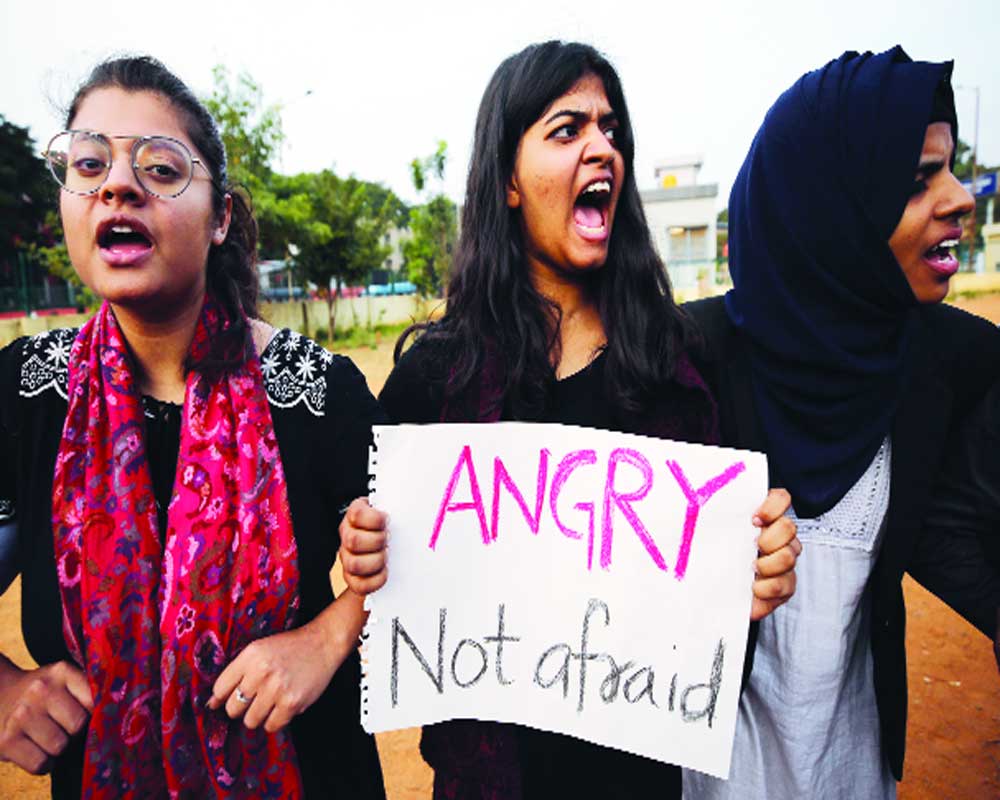Even though, environment is significantly responsible, what is of pressing concern is the reason why some people and not others, go on to exploit that permissive atmosphere and commit sexual crimes
The horrific mass molestation of students at Gargi College — where over 30 men forcibly entered the women’s college — is symptomatic of an atmosphere which is permissive of sexual intimidation. No doubt, sexual harassment is a universal phenomenon, though it may differ in its manifestation, depending upon how a society takes it. Sexual harassment of women in educational institutions is one of the most common and largely underreported forms of gender-based violence, often inflicted by male colleagues, teachers or perpetrators from outside. In a significant number of cases, women adopt a culture of silence as they have learnt to “ignore” certain forms of predatory behaviour of men, like passing lewd comments, wolf-whistling, staring and so on.
Sexual harassment infringes upon the fundamental right of a woman to gender equality under Article 14 and her right to life with dignity under Article 21 of the Constitution, which includes the right to a safe working environment.
Before the Vishaka Guidelines came into existence in 1997, sexual harassment at the workplace was dealt with under Indian Penal Code Section 354, (assault or criminal force to woman with intent to outrage her modesty) and Section 509, punishing the guilty for using a “word, gesture or act intended to insult the modesty of a woman.” However, the interpretation of the provisions on “outraging a woman’s modesty” was left to the police officer.
On the basis of the Vishaka Guidelines, the Sexual Harassment of Women at the Workplace (Prevention, Prohibition and Redressal) Act, 2013 was enacted to ensure safe working spaces for them. Consistent with the Vishaka judgment, the Act provides a civil remedy to women and is in addition to other laws that are currently in force to pursue a criminal case. Consequently, any woman who wishes to report sexual harassment at the workplace has the right to take recourse to both civil and criminal proceedings.
While there is no denying the importance of legal protection against sexual harassment, its public health aspects and their therapeutic interventions are no less important. They need to be examined and addressed to restore the physical and mental health of the victim and go into the reasons for the deviant behaviour of the perpetrators. Even though, environment is significantly responsible, what is of pressing concern is the reason why some people and not others, go on to exploit that permissive atmosphere and commit sexual crimes.
By nature, some people are more hostile, authoritarian and sexist, which might make them more prone to becoming an aggressor. The complexity of the interaction between an aggrieved woman and the perpetrator needs to be understood and the personality profile of the aggressor requires to be examined in depth to evolve effective measures to prevent the occurrence and reduce the prevalence of sexual harassment at the workplace.
Psychological studies show that sexual predators lack a social conscience; they are callous about their social commitments and have a tendency to exaggerate the situation. They justify their misdeeds and legitimise their aggression, particularly against women when it is related to the endorsement of sexually- coercive behaviour.
Studies also show that the psychopathic traits of exploitation of others and lack of empathy, are both commonly associated with rapists, stalkers and molesters. When sexual harassment escalates, it poses a potential risk of a more serious sexual crime like rape. This link highlights the fact that sexual harassers are potential rapists and to prevent rapes, those indulging in harassment need to be treated for their deviant behaviour.
Sexual harassment not only results in strained interpersonal relations and an hostile working environment, it adversely affects the productivity of the organisation, leading to financial losses. But more than anything else, it affects the mindset of the victims, causing a wide range of mental health issues. And as physical health and emotional well-being are inter-related, victims often suffer loss of appetite, headaches, weight fluctuations and sleep disturbance. The commonly-reported negative effects included fear, concerns for safety, and post traumatic stress disorder.
No other form of discrimination has such a wide impact on the physical and mental health of the victims. Sexual harassment has emerged as a major public health problem with long-term physical and mental health consequences for the victims. However, the impact is not restricted to their health and seeps into the victim’s social and professional life. This aspect often gets ignored and victims mostly remain preoccupied with legal remedies. Clinicians have described case histories, symptom profiles, stress factors and attempts at intervention. Theoreticians working in the fields of women’s development, cognitive functioning and gender-based trauma have generated a parallel body of relevant information, applying their theories to the field of harassment.
Sexual harassment presents significant challenges to a victim’s internal and external stability. Primarily recognised as a legal or organisational management issue, it belongs to a clinical continuum with other gender-based abuses. If untreated, it can cause psychiatric illness and long-term negative changes in the victim’s internal perception of self, others, and the world and severely hinder her potential. Appropriate clinical interventions for both, the victims and the perpetrators, can provide an opportunity to assess the seriousness of the crisis and make the workplace free from sexual harassment.
(Writer: RC Jiloha ; Courtesy: The Pioneer)








 OpinionExpress.In
OpinionExpress.In















Comments (0)